steering Alfa Romeo 8C 2007 Owner handbook (in English)
[x] Cancel search | Manufacturer: ALFA ROMEO, Model Year: 2007, Model line: 8C, Model: Alfa Romeo 8C 2007Pages: 223, PDF Size: 14.35 MB
Page 89 of 223
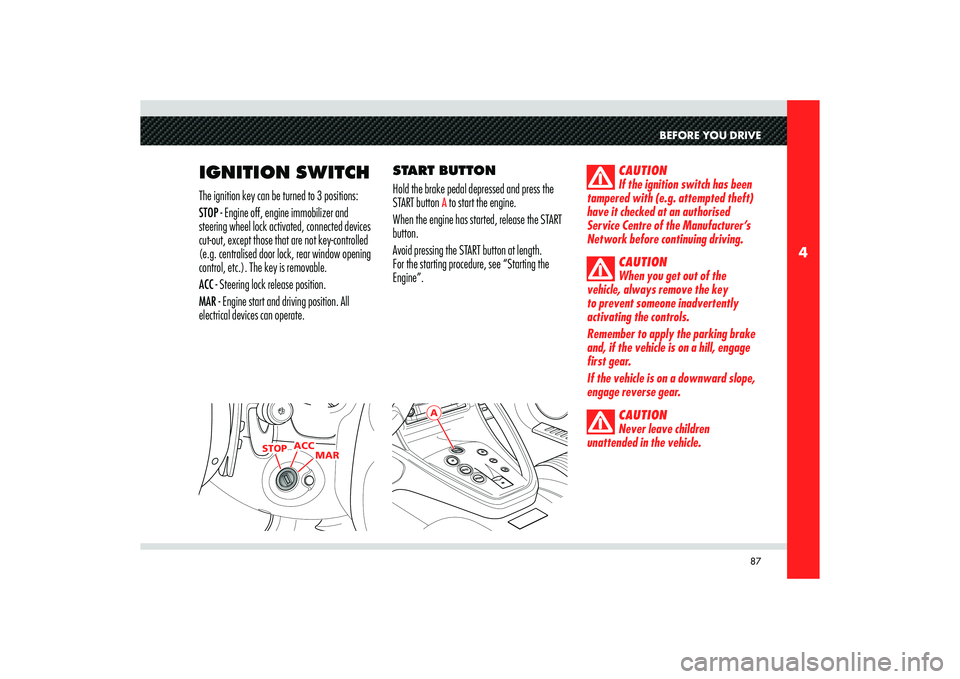
87
4
STOPACC
MAR
A
BEFORE YOU DRIVE
IGNITION SWITCHThe ignition key can be turned to 3 positions:
STOP - Engine off, engine immobilizer and
steering wheel lock activated, connected devices
cut-out, except those that are not key-controlled
(e.g. centralised door lock, rear window opening
control, etc.). The key is removable.
ACC - Steering lock release position.
MAR - Engine start and driving position. All
electrical devices can operate.START BUTTON
Hold the brake pedal depressed and press the
START button
A to start the engine.
When the engine has started, release the START
button.
Avoid pressing the START button at length.
For the starting procedure, see “Starting the
Engine”.
CAUTION
If the ignition switch has been
tampered with (e.g. attempted theft)
have it checked at an authorised
Service Centre of the Manufacturer’s
Network before continuing driving.
CAUTION
When you get out of the
vehicle, always remove the key
to prevent someone inadvertently
activating the controls.
Remember to apply the parking brake
and, if the vehicle is on a hill, engage
first gear.
If the vehicle is on a downward slope,
engage reverse gear.
CAUTION
Never leave children
unattended in the vehicle.
Page 96 of 223
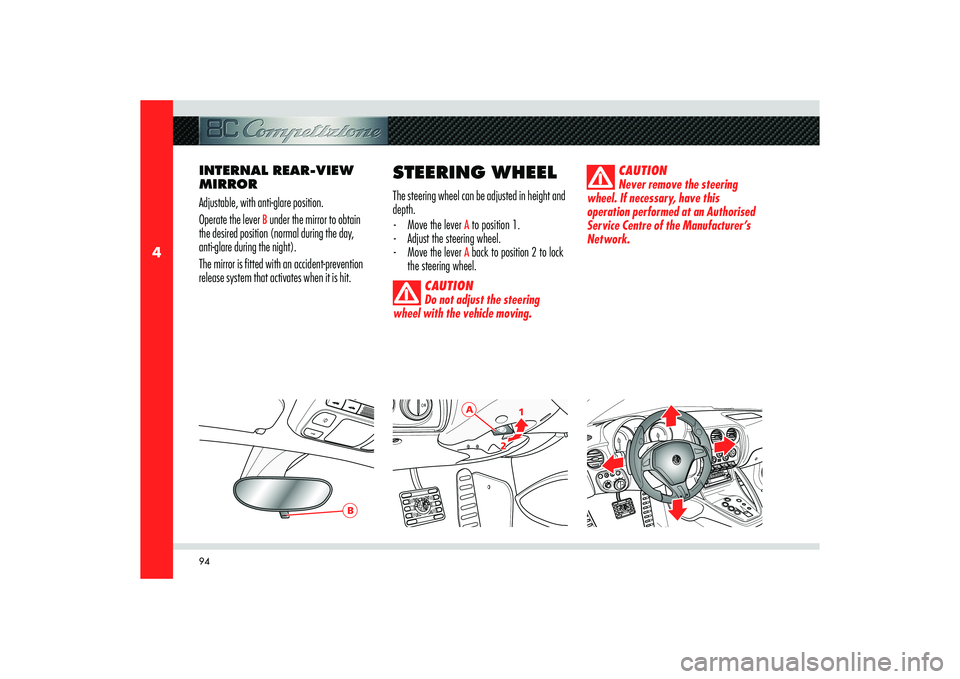
94
4
B
A
2
1
21
INTERNAL REAR-VIEW
MIRROR
Adjustable, with anti-glare position.
Operate the lever
B under the mirror to obtain
the desired position (normal during the day,
anti-glare during the night).
The mirror is fitted with an accident-prevention
release system that activates when it is hit.
STEERING WHEELThe steering wheel can be adjusted in height and
depth.
- Move the lever
A to position 1.
- Adjust the steering wheel.
- Move the lever A back to position 2 to lock
the steering wheel.
CAUTION
Do not adjust the steering
wheel with the vehicle moving.CAUTION
Never remove the steering
wheel. If necessary, have this
operation performed at an Authorised
Service Centre of the Manufacturer’s
Network.
Page 100 of 223
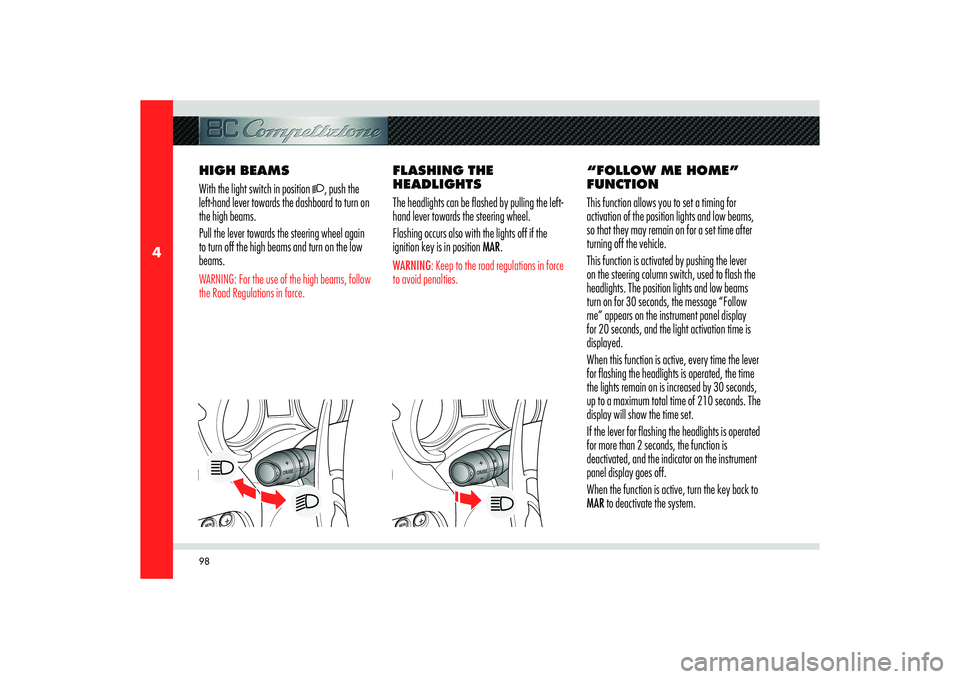
98
4
HIGH BEAMS
With the light switch in position
, push the
left-hand lever towards the dashboard to turn on
the high beams.
Pull the lever towards the steering wheel again
to turn off the high beams and turn on the low
beams.
WARNING: For the use of the high beams, follow
the Road Regulations in force.
FLASHING THE
HEADLIGHTS
The headlights can be flashed by pulling the left-
hand lever towards the steering wheel.
Flashing occurs also with the lights off if the
ignition key is in position MAR.WARNING: Keep to the road regulations in force
to avoid penalties.
“FOLLOW ME HOME”
FUNCTION
This function allows you to set a timing for
activation of the position lights and low beams,
so that they may remain on for a set time after
turning off the vehicle.
This function is activated by pushing the lever
on the steering column switch, used to flash the
headlights. The position lights and low beams
turn on for 30 seconds, the message “Follow
me” appears on the instrument panel display
for 20 seconds, and the light activation time is
displayed.
When this function is active, every time the lever
for flashing the headlights is operated, the time
the lights remain on is increased by 30 seconds,
up to a maximum total time of 210 seconds. The
display will show the time set.
If the lever for flashing the headlights is operated
for more than 2 seconds, the function is
deactivated, and the indicator on the instrument
panel display goes off.
When the function is active, turn the key back to
MAR to deactivate the system.
Page 101 of 223
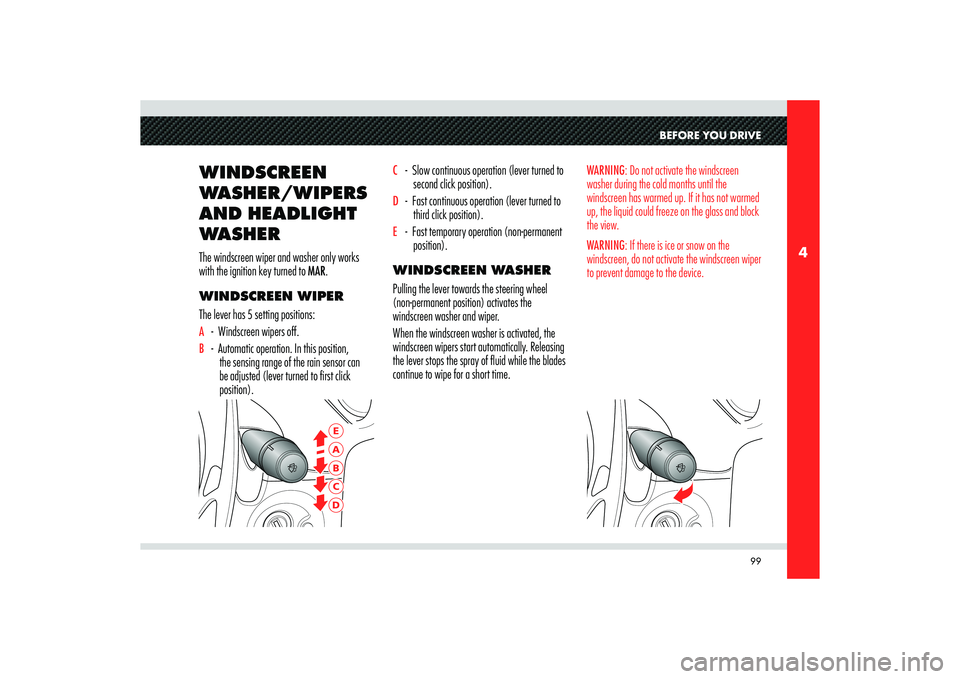
99
4
BAECD
BEFORE YOU DRIVE
WINDSCREEN
WASHER/WIPERS
AND HEADLIGHT
WASHERThe windscreen wiper and washer only works
with the ignition key turned to MAR.
WINDSCREEN WIPER
The lever has 5 setting positions:A - Windscreen wipers off.B - Automatic operation. In this position,
the sensing range of the rain sensor can
be adjusted (lever turned to first click
position).
C - Slow continuous operation (lever turned to
second click position).D - Fast continuous operation (lever turned to
third click position).E - Fast temporary operation (non-permanent
position).
WINDSCREEN WASHER
Pulling the lever towards the steering wheel
(non-permanent position) activates the
windscreen washer and wiper.
When the windscreen washer is activated, the
windscreen wipers start automatically. Releasing
the lever stops the spray of fluid while the blades
continue to wipe for a short time.
WARNING: Do not activate the windscreen
washer during the cold months until the
windscreen has warmed up. If it has not warmed
up, the liquid could freeze on the glass and block
the view.
WARNING: If there is ice or snow on the
windscreen, do not activate the windscreen wiper
to prevent damage to the device.
Page 116 of 223
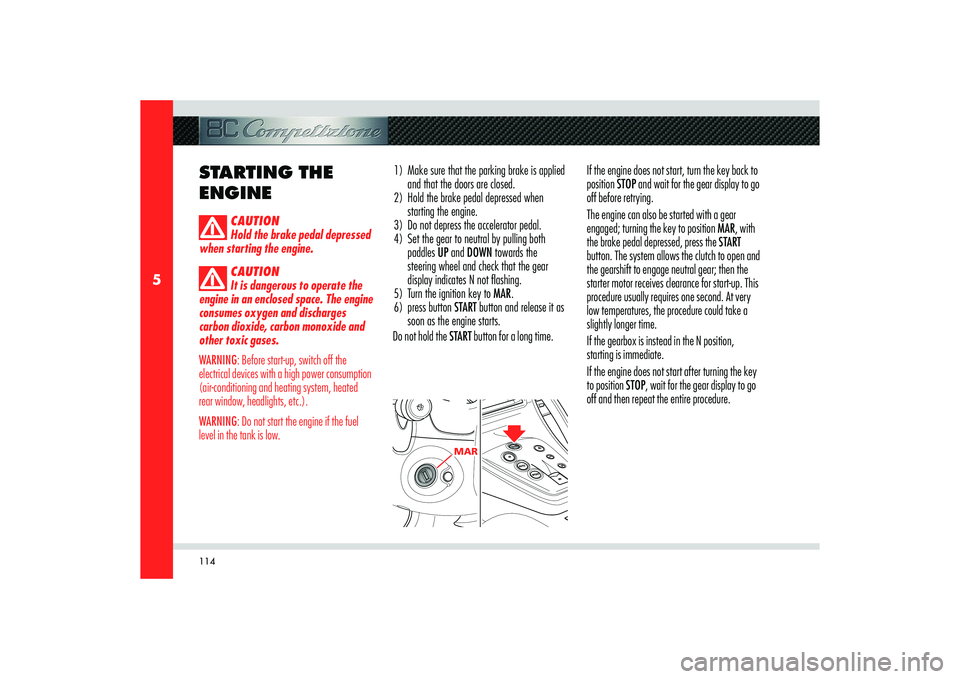
114
5
MAR
STARTING THE
ENGINE
CAUTION
Hold the brake pedal depressed
when starting the engine.
CAUTION
It is dangerous to operate the
engine in an enclosed space. The engine
consumes oxygen and discharges
carbon dioxide, carbon monoxide and
other toxic gases.
WARNING: Before start-up, switch off the
electrical devices with a high power consumption
(air-conditioning and heating system, heated
rear window, headlights, etc.).
WARNING: Do not start the engine if the fuel
level in the tank is low.
1) Make sure that the parking brake is applied
and that the doors are closed.
2) Hold the brake pedal depressed when
starting the engine.
3) Do not depress the accelerator pedal.
4) Set the gear to neutral by pulling both
paddles UP and DOWN towards the
steering wheel and check that the gear
display indicates N not fl ashing.
5) Turn the ignition key to MAR.
6) press button START button and release it as
soon as the engine starts.
Do not hold the START button for a long time.If the engine does not start, turn the key back to
position STOP and wait for the gear display to go
off before retrying.
The engine can also be started with a gear
engaged; turning the key to position MAR, with
the brake pedal depressed, press the START
button. The system allows the clutch to open and
the gearshift to engage neutral gear; then the
starter motor receives clearance for start-up. This
procedure usually requires one second. At very
low temperatures, the procedure could take a
slightly longer time.
If the gearbox is instead in the N position,
starting is immediate.
If the engine does not start after turning the key
to position STOP, wait for the gear display to go
off and then repeat the entire procedure.
Page 118 of 223
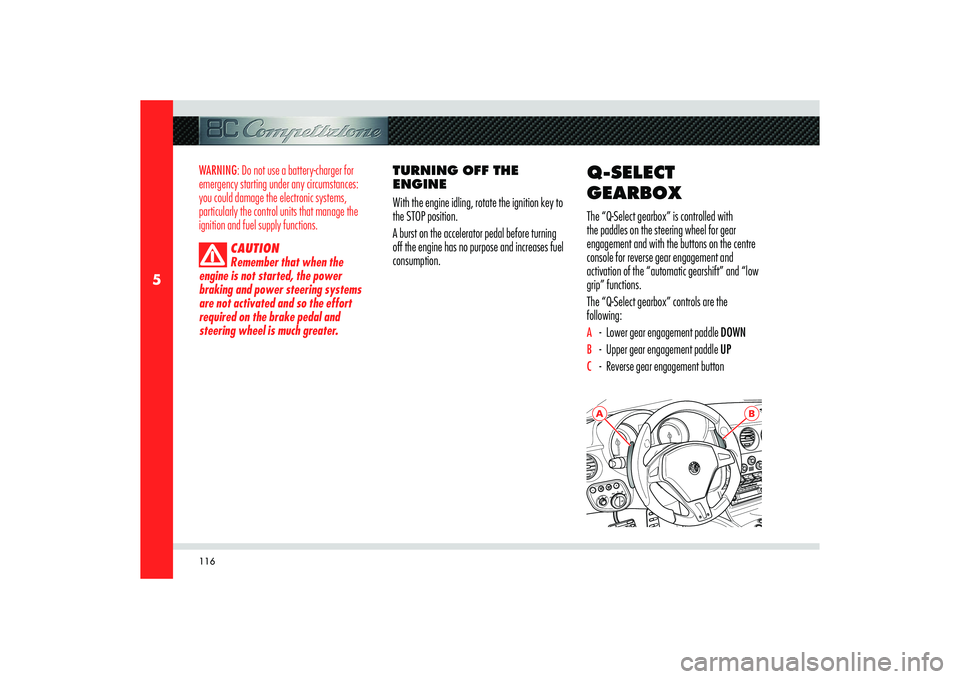
116
5
A
B
WARNING: Do not use a battery-charger for
emergency starting under any circumstances:
you could damage the electronic systems,
particularly the control units that manage the
ignition and fuel supply functions.
CAUTION
Remember that when the
engine is not started, the power
braking and power steering systems
are not activated and so the effort
required on the brake pedal and
steering wheel is much greater.
TURNING OFF THE
ENGINE
With the engine idling, rotate the ignition key to
the STOP position.
A burst on the accelerator pedal before turning
off the engine has no purpose and increases fuel
consumption.
Q-SELECT
GEARBOXThe “Q-Select gearbox” is controlled with
the paddles on the steering wheel for gear
engagement and with the buttons on the centre
console for reverse gear engagement and
activation of the “automatic gearshift” and “low
grip” functions.
The “Q-Select gearbox” controls are the
following:A - Lower gear engagement paddle DOWNB - Upper gear engagement paddle UPC - Reverse gear engagement button
Page 120 of 223
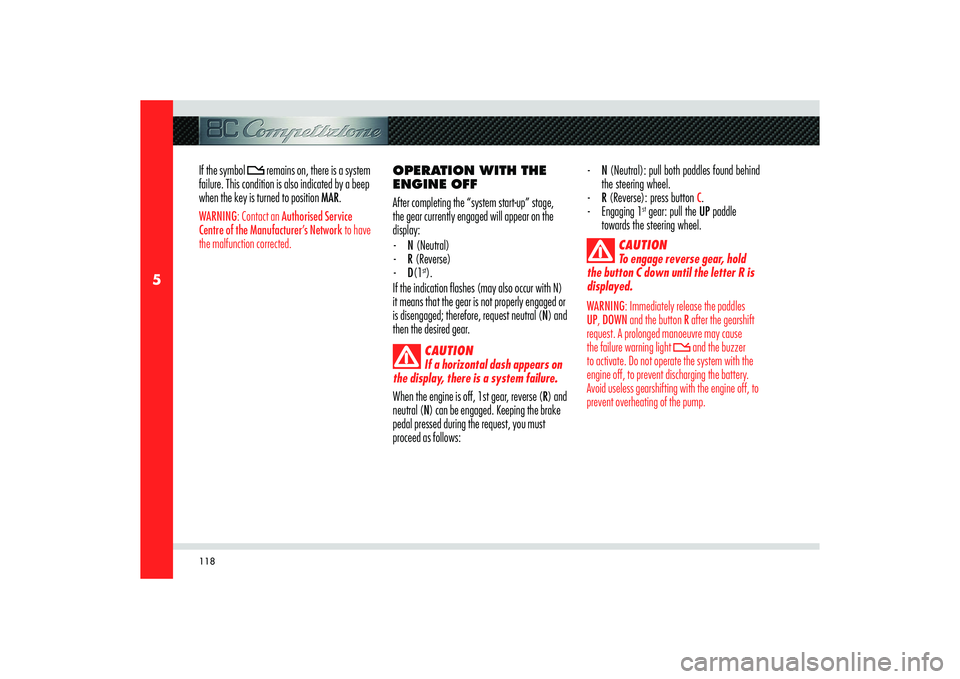
118
5
If the symbol
remains on, there is a system
failure. This condition is also indicated by a beep
when the key is turned to position MAR.
WARNING: Contact an Authorised Service
Centre of the Manufacturer’s Network to have
the malfunction corrected.
OPERATION WITH THE
ENGINE OFF
After completing the “system start-up” stage,
the gear currently engaged will appear on the
display:
- N (Neutral)
- R (Reverse)
- D(1
st).
If the indication flashes (may also occur with N)
it means that the gear is not properly engaged or
is disengaged; therefore, request neutral (N) and
then the desired gear.CAUTION
If a horizontal dash appears on
the display, there is a system failure.
When the engine is off, 1st gear, reverse (R) and
neutral (N) can be engaged. Keeping the brake
pedal pressed during the request, you must
proceed as follows:
- N (Neutral): pull both paddles found behind
the steering wheel.
- R (Reverse): press button
C.
- Engaging 1
st gear: pull the UP paddle
towards the steering wheel.
CAUTION
To engage reverse gear, hold
the button C down until the letter R is
displayed.
WARNING: Immediately release the paddles
UP, DOWN and the button R after the gearshift
request. A prolonged manoeuvre may cause
the failure warning light
and the buzzer
to activate. Do not operate the system with the
engine off, to prevent discharging the battery.
Avoid useless gearshifting with the engine off, to
prevent overheating of the pump.
Page 121 of 223
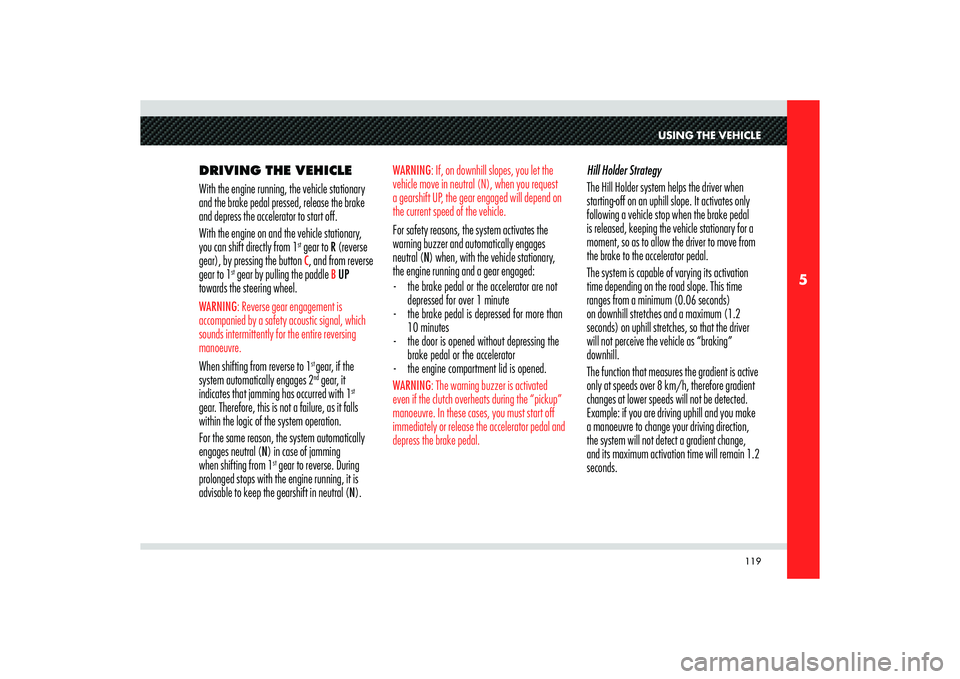
119
5
USING THE VEHICLE
DRIVING THE VEHICLE
With the engine running, the vehicle stationary
and the brake pedal pressed, release the brake
and depress the accelerator to start off.
With the engine on and the vehicle stationary,
you can shift directly from 1
st gear to R (reverse
gear), by pressing the button C, and from reverse
gear to 1
st gear by pulling the paddle
B UP
towards the steering wheel.
WARNING: Reverse gear engagement is
accompanied by a safety acoustic signal, which
sounds intermittently for the entire reversing
manoeuvre. When shifting from reverse to 1
st gear, if the
system automatically engages 2nd gear, it
indicates that jamming has occurred with 1
st
gear. Therefore, this is not a failure, as it falls
within the logic of the system operation.
For the same reason, the system automatically
engages neutral (N) in case of jamming
when shifting from 1
st gear to reverse. During
prolonged stops with the engine running, it is
advisable to keep the gearshift in neutral (N).Hill Holder Strategy
The Hill Holder system helps the driver when
starting-off on an uphill slope. It activates only
following a vehicle stop when the brake pedal
is released, keeping the vehicle stationary for a
moment, so as to allow the driver to move from
the brake to the accelerator pedal.
The system is capable of varying its activation
time depending on the road slope. This time
ranges from a minimum (0.06 seconds)
on downhill stretches and a maximum (1.2
seconds) on uphill stretches, so that the driver
will not perceive the vehicle as “braking”
downhill.
The function that measures the gradient is active
only at speeds over 8 km/h, therefore gradient
changes at lower speeds will not be detected.
Example: if you are driving uphill and you make
a manoeuvre to change your driving direction,
the system will not detect a gradient change,
and its maximum activation time will remain 1.2
seconds.
WARNING: If, on downhill slopes, you let the
vehicle move in neutral (N), when you request
a gearshift UP, the gear engaged will depend on
the current speed of the vehicle. For safety reasons, the system activates the
warning buzzer and automatically engages
neutral (N) when, with the vehicle stationary,
the engine running and a gear engaged:
- the brake pedal or the accelerator are not
depressed for over 1 minute
- the brake pedal is depressed for more than
10 minutes
- the door is opened without depressing the
brake pedal or the accelerator
- the engine compartment lid is opened.WARNING: The warning buzzer is activated
even if the clutch overheats during the “pickup”
manoeuvre. In these cases, you must start off
immediately or release the accelerator pedal and
depress the brake pedal.
Page 123 of 223

121
5
USING THE VEHICLE
REQUESTING
NEUTRAL (N)
If necessary, neutral (N) can be requested at any
speed.
If you then operate the UP paddle, the system
will engage a gear suited to the vehicle speed.
STOPPING THE VEHICLE
When the vehicle stops, the system
automatically engages 1
st gear (unless N has
already bee requested).
With the vehicle stationary and the engine
running, hold the brake pedal depressed until
you are ready to start off again. TURNING OFF
THE ENGINE AND
DEACTIVATING THE
SYSTEM
The engine can only be turned off with the
gearbox in 1
st, or reverse gear R.
If the gear is in neutral and the key is turned
from MAR to position STOP, the display remains
on for a few seconds showing the letter (N)
flashing and activating the acoustic signal.
For safety reasons, to avoid undesired and
sudden vehicle movements:
CAUTION
Never leave the vehicle with
the gear in neutral (N), but engage
1
st or reverse gear and check that the
parking brake has been engaged. Do
not leave the vehicle with the engine
running.CAUTION
Do not remove the key when
the vehicle is moving! The system (and
thus the display) would remain active
but malfunctioning, until the vehicle
stops; in addition, the steering wheel
would lock automatically at the first
turn of the wheel.
In this case, the failure symbol
will
illuminate and, before starting-off again, the
system must be turned off and the “system start-
up” phase repeated.
In any event, it is best to:
- Turn off the engine and the system holding
the brake pedal depressed.
- Do not request a gearshift while the system
is turning off.
Page 127 of 223
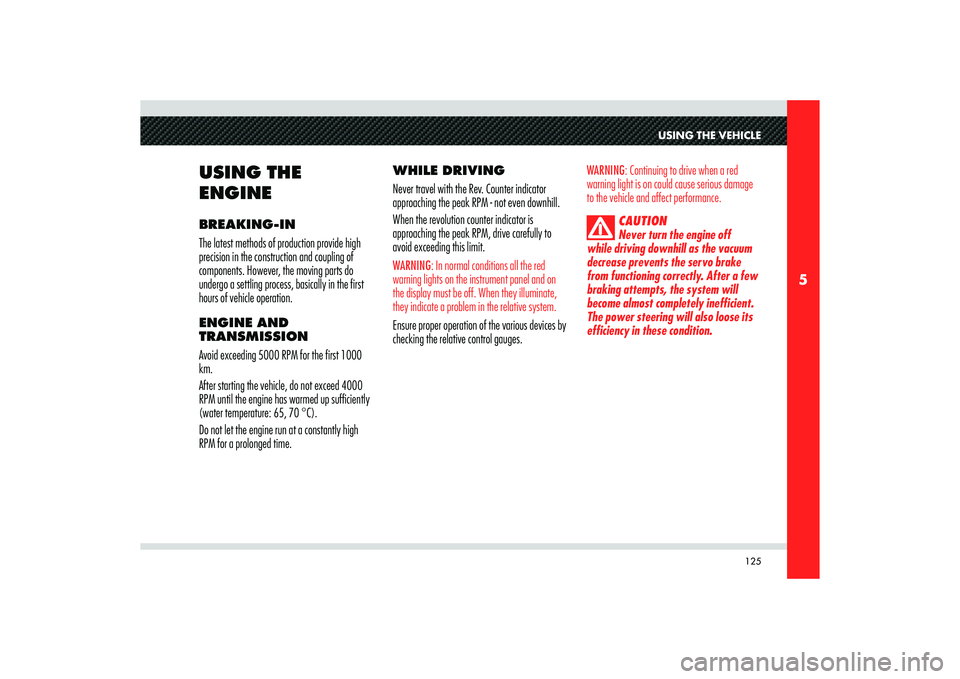
125
5
USING THE VEHICLE
USING THE
ENGINEBREAKING-IN
The latest methods of production provide high
precision in the construction and coupling of
components. However, the moving parts do
undergo a settling process, basically in the first
hours of vehicle operation.
ENGINE AND
TRANSMISSION
Avoid exceeding 5000 RPM for the first 1000
km.
After starting the vehicle, do not exceed 4000
RPM until the engine has warmed up sufficiently
(water temperature: 65, 70 °C).
Do not let the engine run at a constantly high
RPM for a prolonged time.WHILE DRIVING
Never travel with the Rev. Counter indicator
approaching the peak RPM - not even downhill.
When the revolution counter indicator is
approaching the peak RPM, drive carefully to
avoid exceeding this limit.
WARNING: In normal conditions all the red
warning lights on the instrument panel and on
the display must be off. When they illuminate,
they indicate a problem in the relative system.Ensure proper operation of the various devices by
checking the relative control gauges.
WARNING: Continuing to drive when a red
warning light is on could cause serious damage
to the vehicle and affect performance.
CAUTION
Never turn the engine off
while driving downhill as the vacuum
decrease prevents the servo brake
from functioning correctly. After a few
braking attempts, the system will
become almost completely inefficient.
The power steering will also loose its
efficiency in these condition.